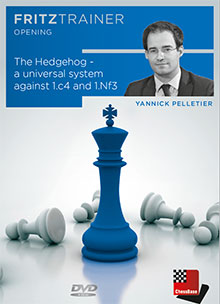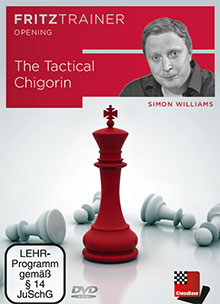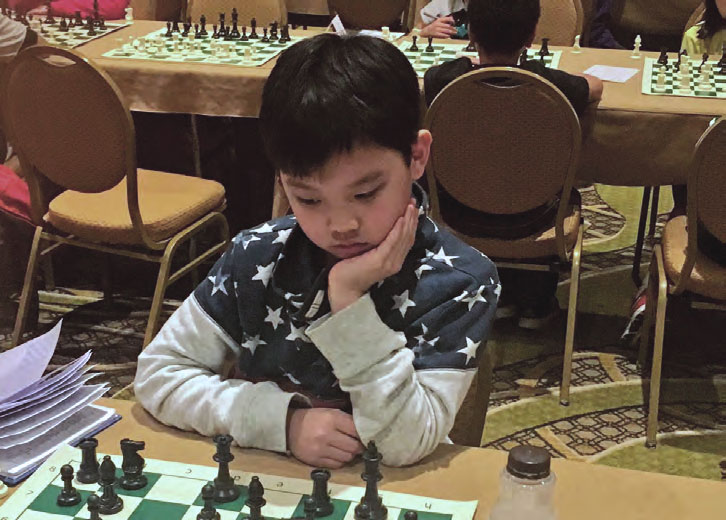How to lose to a 9-year-old at chess
Grumpy old git Steve Barrett bemoans the increasingly common experience of playing highly talented precocious youngsters at chess tournaments — and what to say to your friends when you lose to someone barely tall enough to see over the board.
Talented young chess players are not a new phenomenon, of course. There have been prodigies before. Think of Paul Morphy, already one of the best players in New Orleans by the age of nine; Sammy Reshevsky giving high-profile simultaneous displays aged six; and Capablanca beating his father in skittles games at the age of four.
What has changed is an explosion in youth and school chess that has multiplied the number of precocious young players on the scene. I didn’t even start playing chess competitively until I was 13 years old. These days, if you’re not on the path to becoming an IM by then, you’re as good as past it.
Chess is hard and stressful at the best of times. I was struck by Simon Williams’ and Lawrence Trent’s discussion on a recent episode of The Full English Breakfast podcast about how difficult it is to win any game these days, no matter who you are playing.

They were bemoaning their respective performances at the British Championship in Llandudno and noting how even lowly-rated players nowadays fight so hard and are capable of great chess. The days of cruising through the first few rounds of an open Swiss are long gone — you have to be on your mettle from the start.
But in addition to this it’s now quite possible to play a weekend tournament and not get to face off with an adult in any of the five or six rounds. There is little doubt chess is now a young person’s game, and this old timer has observed that good manners and attention to chess etiquette are not top of the new generation’s agenda.
Most regular tournament players have experienced it. You turn up for the round to be confronted by a small human who is barely big enough to lean over the board to shake hands, who frankly doesn’t know how to shake hands properly anyway. They display the brashness and confidence of youth and hundreds of hours playing online, bolstered by regular sessions with their IM or GM coaches. They rarely bother centring the pieces on the squares at the start of the game and they toss their moves out casually and with bravado.
I’m not sure if they are taught to play their games to the bitter end by their coaches, but their refusal to resign in totally lost positions is very irritating. I once played next to a former Russian GM now residing in Connecticut who was forced to checkmate his young opponent when two rooks and a knight up. He was not impressed and told the boy gruffly afterwards in no uncertain terms: “Why you not resign? I am Grand Master.”
The little mites also have an inappropriate tendency to offer multiple draws in the same game, when it is not their place to do so in the first place and is in fact against the laws of the game, as Nigel Short noted in his New in Chess column after drawing with an 11-year-old Indian player in the Abu Dhabi Masters this summer. They also like to stare you down during the game, presumably thinking you are going to be intimidated. And they never blow their noses, preferring instead to sniff constantly — and annoyingly.
Then there are their entourages of parents and siblings, who cluster in every available free space in the chess venues as they pass the interminable hours during and between games, causing you to trip over them when you head to the bathroom. And those parents so want their kids to do well. You can feel their vicarious ambition on behalf of their offspring as they survey their games and stock them up with drinks and snacks designed not to send their hyperactivity through the roof.
I’m being a grumpy old git of course. What is most annoying is that many of them are really good at the game I have spent decades trying unsuccessfully to master, despite being so young. They will outplay you if you give them the merest sniff of a chance, especially in sharp positions. Even the tried and trusted technique of taking them into endgames to neutralise their computer-like tactical abilities isn’t a sure-fire winner, because they never give up and are always looking for resources — another benefit of their coaching.
The worst part of all this, and what makes it particularly annoying, is trying to explain to your non-chess-playing friends how it is possible to lose at chess to a 9-year-old. They find it highly amusing of course.
I’ve tried numerous strategies to try and neutralise the fearlessness of youth over the chessboard, the most common of which is to head for endgames where your experience is likely to overcome their precocity. No ending should be too dry to aim for in this context.
Take this example from a recent weekend tournament I played in New York’s state capital of Albany, where I faced off against a 9-year-old in round 2.

[Event "Peter Henner Memorial, Albany"] [Site "?"] [Date "2017.??.??"] [Round "?"] [White "Prestia, F."] [Black "Barrett, S."] [Result "0-1"] [ECO "E90"] [Annotator "Steve Barrett"] [PlyCount "118"] [EventDate "2017.??.??"] [SourceTitle "Chess 2017 #11"] [SourceDate "2017.10.24"] 1. d4 Nf6 2. c4 g6 3. Nc3 Bg7 4. e4 d6 5. Nf3 O-O 6. h3 e5 7. d5 Na6 8. Bg5 h6 9. Be3 Nh5 10. Qd2 Kh7 11. g4 Nf4 12. Ne2 Nxe2 13. Bxe2 f5 14. exf5 gxf5 15. g5 f4 16. Qc2+ Kh8 (16... Bf5 17. Bd3 Bxd3 18. Qxd3+ Kh8 19. gxh6 Bf6 {would have been even better.}) 17. gxh6 Bxh6 18. Bd2 Nc5 {Again, keeping it simple;} ({ but it was possible to go} 18... Bf5 $5 19. Bd3 e4 {, and if} 20. Bc3+ Bg7 21. Bxg7+ Kxg7 22. Qc3+ Kh6 {.}) 19. b4 Bf5 20. Qb2 Nd3+ 21. Bxd3 Bxd3 22. Qc3 Bh7 23. Rg1 Qf6 24. h4 Rg8 25. O-O-O Rxg1 26. Rxg1 Rg8 27. Rxg8+ Kxg8 28. c5 Qf5 29. Qb3 Qd3 {Resolutely avoiding complications and taking the kid into an ending, after which his previously quick, confident, and aggressive play dissolved in the face of a plain opposite-coloured bishop ending. ---} 30. Qxd3 Bxd3 31. cxd6 cxd6 32. Ng5 Bxg5 33. hxg5 b5 34. Bc3 Bc4 35. a3 Bxd5 36. Kd2 Kg7 37. Kd3 Kg6 38. Ke2 Kxg5 39. f3 Bc4+ 40. Kf2 Kf5 41. Bb2 Ke6 42. Bc3 Kd5 43. Bb2 Bd3 44. Ke1 Kc4 45. Kd2 Kb3 46. Bc1 Bc4 47. Kd1 Bd5 48. Ke2 Kc2 49. Bd2 Bxf3+ 50. Ke1 a6 51. a4 Bg4 52. axb5 axb5 53. Kf1 Kxd2 54. Kf2 e4 55. Kf1 e3 56. Kg1 e2 57. Kf2 e1=Q+ 58. Kg2 Qg3+ 59. Kf1 Bh3# 0-1
Here’s another example, back up in Albany again a few weeks later for the longest-running tournament in U.S. chess history, against a 9-year-old this time.

[Event "New York State Championship, Albany"] [Site "?"] [Date "2017.??.??"] [Round "?"] [White "Putnam, L."] [Black "Barrett, S."] [Result "0-1"] [ECO "E81"] [Annotator "Steve Barrett"] [PlyCount "76"] [EventDate "2017.??.??"] [SourceTitle "Chess 2017 #11"] [SourceDate "2017.10.24"] 1. d4 Nf6 2. c4 g6 3. Nc3 Bg7 4. e4 d6 5. f3 O-O 6. Be3 Nbd7 7. Qd2 c5 8. Nge2 a6 9. g3 Qa5 10. Nd5 {I was very happy to see this. His aggressive opening is duly neutralized and queens come off the board. Time to play an endgame youngster...} Qxd2+ 11. Kxd2 Nxd5 12. cxd5 f5 13. Bg2 fxe4 14. fxe4 cxd4 15. Nxd4 Ne5 16. Bf1 $2 {Now White will lose the dark squares.} (16. Rhc1 {was the way to go.}) 16... Ng4 17. Be2 Nf2 18. Bxf2 Rxf2 19. Nf3 $6 (19. Ne6 Bxe6 20. dxe6 Rc8 {was a better try, if still good for Black.}) 19... Bg4 20. Rhf1 (20. Ke3 Rg2 21. Raf1 Rc8 22. h3 Bh6+ 23. Kd3 Bd7 24. Nd4 Rxg3+ {would but be a faster exit.}) 20... Rg2 21. Ng1 Rxh2 22. Kd3 Bd7 23. a4 Bxb2 24. Rab1 Bf6 25. Rxb7 Bxa4 26. Bg4 Bb5+ 27. Ke3 {Obviously resigning is the right thing to do here, but as previously indicated that does not seem to be in the coaching manuals of some of these young kids.} Bxf1 28. Be6+ Kf8 29. Nf3 Rb2 30. Rxb2 Bxb2 31. Kf2 Bc4 32. Ng5 h6 33. Nf7 Kg7 34. g4 a5 35. g5 hxg5 36. Nxg5 a4 37. Bg4 a3 38. Ne6+ Kf6 {. He finally took the hint and resigned.} 0-1
Don’t assume they can’t play endings at all though. This example against an 11-year-old came from a tournament in Manhattan and rounded off a tough and frustrating weekend of chess grind for me.

[Event "Manhattan Open, New York"] [Site "?"] [Date "2017.??.??"] [Round "?"] [White "Hu, M."] [Black "Barrett, S."] [Result "1/2-1/2"] [ECO "B83"] [Annotator "Steve Barrett"] [PlyCount "122"] [EventDate "2017.??.??"] [SourceTitle "Chess 2017 #11"] [SourceDate "2017.10.24"] 1. e4 c5 2. Nf3 e6 3. d4 cxd4 4. Nxd4 Nf6 5. Nc3 d6 6. Be2 Be7 7. O-O Nc6 8. Be3 Bd7 9. f4 O-O 10. a4 Nxd4 11. Qxd4 Bc6 12. Bf3 Nd7 13. Rad1 e5 14. Qd2 exf4 15. Bxf4 Ne5 16. Nd5 Bxd5 17. Qxd5 Qc7 18. Qb3 Rac8 19. c3 Bf6 20. Rd5 b6 21. Be2 Qe7 22. Rfd1 Rfd8 23. Kh1 g6 24. Kg1 Kg7 25. Qc2 Rc5 26. Qd2 Rxd5 27. Qxd5 Bg5 28. Bxe5+ dxe5 29. Qc4 ({Not falling for} 29. Qxd8 $4 Qc5+ {.}) 29... Be3+ {Heading for another opposite-coloured bishop ending, this time with the addition of queens on the board.} 30. Kh1 Rxd1+ 31. Bxd1 Qf6 32. Qe2 Qf4 33. Qf3 Bc1 34. b3 (34. Qxf4 exf4 35. b3 Bd2 36. c4 Kf6 37. Kg1 Ke5 {leaves Black with all the trumps as his king invades.}) 34... Qd2 35. Be2 Bb2 36. c4 Bd4 37. g3 Qc2 38. Kg2 $2 Bc3 39. g4 h6 40. h4 Qc1 $2 {He bluffed me and I lost my nerve in sight of victory.} (40... Qxb3 41. g5 {looked very frightening heading into the fourth hour of the final game of an exhausting weekend - another factor that us oldies have to contend with, especially with the prospect of work the next morning. However,} hxg5 42. hxg5 Kg8 {is fine as I can retreat my bishop around the angles and keep my king covered up and safe: for example,} 43. Qf6 Qb2 44. Qd8+ Kh7 45. Kf3 Bb4 46. Qf6 Kg8 47. Qd8+ Bf8 48. Qd3 Qc1 {.}) 41. Kh3 Bd4 42. Qf1 Qd2 43. Qf3 Be3 44. Bd1 Bf4 45. Qe2 Qd4 46. Kg2 Qc3 47. Qf3 Qe1 48. h5 g5 49. Be2 a5 50. Qd3 Qh4 51. Qh3 Kf6 52. Qxh4 gxh4 53. c5 bxc5 54. Bc4 Kg5 55. Kh3 f6 56. Bf7 Bg3 57. Be6 Kf4 58. Bd5 Ke3 59. Kg2 Kf4 60. Kh3 Kf3 61. Bc6 Kf4 {. He had offered me six draws by this stage, much to my extreme annoyance, but finally I had to succumb to the inevitable.} 1/2-1/2
But all of these examples are simply a preamble to the main point of this article, my latest ego-crushing defeat at the hands of one of the new generation of kids, from the first event up in Albany. I’d started the tournament pretty well, winning my first two games and going down in a tough encounter with GM Alexander Ivanov in the third round on Saturday evening in which I may have been better at one point.
As such, I was in reasonably good spirits when I rocked up on Sunday morning and looking forward to finishing the tournament strongly, only to be confronted with my nightmare scenario: a 9-year-old wunderkind named Liran Zhou. Zhou’s rating was an unassuming 1839 at the time, but he soon demonstrated he was much stronger than that by quickly and confidently outplaying me.

[Event "Peter Henner Memorial, Albany"] [Site "?"] [Date "2017.??.??"] [Round "?"] [White "Zhou, L."] [Black "Barrett, S."] [Result "1-0"] [ECO "B81"] [Annotator "Steve Barrett"] [PlyCount "69"] [EventDate "2017.??.??"] [SourceTitle "Chess 2017 #11"] [SourceDate "2017.10.24"] 1. e4 c5 2. Nf3 e6 3. d4 cxd4 4. Nxd4 Nf6 5. Nc3 d6 6. g4 a6 7. g5 Nfd7 8. Be3 b5 9. Qd2 Nb6 10. f4 N8d7 11. Qf2 Bb7 12. f5 exf5 13. Nxf5 Nc4 $2 ({I had intended} 13... b4 {, but was worried about the nasty} 14. Nb5 ({which incidentally he had not seen; he was going to play} 14. Nd5 Nxd5 15. exd5 { with a slight advantage}) 14... axb5 15. Bxb5 Bxe4 (15... Na4 16. Rf1 f6 17. gxf6 gxf6 18. O-O-O {is very good for White}) {so White should prefer} 16. O-O ({However, after} 16. Bxb6 Qxg5 17. Rf1 Bxf5 18. Qxf5 Qxf5 19. Rxf5 {, Black seems to be holding;} (19. --)) 16... Bxf5 17. Qxf5 Qc7 18. Bxd7+ Qxd7 ({ and not} 18... Nxd7 $2 19. Qe4+) 19. Bxb6 Qxf5 20. Rxf5 {with only an edge.}) 14. Bxc4 bxc4 15. O-O-O Ne5 16. Bf4 Qc7 17. Bxe5 dxe5 18. Nd5 Bxd5 19. exd5 O-O-O 20. Qf3 (20. d6 Bxd6 21. Rxd6 Rxd6 22. Nxd6+ Qxd6 23. Qxf7 {is also effective.}) 20... Bd6 21. Nxg7 Rhg8 22. Nf5 Rxg5 23. c3 Kb8 24. Rhg1 {Zhou continues to play quickly and confidently, keeping the pressure on and causing me to crack.} Rg6 $2 (24... Rxg1 25. Rxg1 e4 26. Qxe4 Bxh2 27. Rf1 Qe5 { was the way to try and defend.}) 25. Qe4 Rdg8 26. Rg3 Qc5 27. Rf1 Bc7 28. d6 Bd8 29. d7 $2 Kc7 $2 30. Rd1 Rxg3 31. hxg3 Bg5+ 32. Kb1 Rd8 33. Nd6 Rxd7 34. Qb7+ Kd8 35. Nxf7+ 1-0
Zhou learned the game three years ago and recently went over the 2200 USCF rating barrier, becoming the youngest National Master in U.S. chess history. I must stress that, contrary to my curmudgeonly complaints above, he behaved impeccably at the board and was a pleasure to play against, apart from annoying me by continuing to find such good moves that is.
In August, Zhou won the World Cadets Under-10 Chess Championship in Brazil – essentially the World Youth Championship for younger kids. So maybe on reflection it wasn’t such a disaster to lose to him – and when he’s a Grandmaster and perhaps even one day U.S. Champion, at least I can say I played him.
As I told my friends once they’d picked themselves up from the floor after dissolving in laughter, that’s how to lose to a 9-year-old at chess.
Correction November 11: Frank Prestia is still 9 years old, not 10 as originally stated. His birthday is at the end of December.
Published in the November 2017 issue of CHESS and reproduced with kind permission.

CHESS Magazine was established in 1935 by B.H. Wood who ran it for over fifty years. It is published each month by the London Chess Centre and is edited by IM Richard Palliser and Matt Read. The Executive Editor is Malcolm Pein, who organises the London Chess Classic.
CHESS is mailed to subscribers in over 50 countries. You can subscribe from Europe and Asia at a specially discounted rate for first timers, or subscribe from North America.
ChessBase software from Chess & Bridge
 ChessBase Magazine 180
ChessBase Magazine 180
ChessBase PC-DVD
RRP £17.95 SUBSCRIBERS £16.15
The latest issue of CBM is for ‘October/November 2017’, although its focus is the November 2017 summer bonanza of chess we all got to enjoy, not least the super-strong tournaments in Biel, Geneva and St. Louis. As ever there are also plenty of theoretical opening surveys, with Mihail Marin supplying a special video contribution on the Catalan.
Order online from
The London Chess Centre or Chess4Less (USA)
 CORR Database 2018
CORR Database 2018
ChessBase PC-DVD
RRP £169.99 SUBSCRIBERS £152.99
The latest issue of the major correspondence database now contains a whopping 1,431, 813 games right up to and including some from 2017. All who dabble in the field of correspondence chess should find plenty of material to prepare from here, but those over-the-board players who are really into their theory may also enjoy trawling through the more topical lines debated of late by the world’s leading correspondence players. After all many an OTB novelty has turned out to have been tested before in email practice. Those who want to upgrade from their CORR Database 2015 may do so for £80.99 (Subscribers – £72.89), and by quoting their existing serial number to Chess & Bridge.
Order online from
The London Chess Centre or Chess4Less (USA)
 Houdini 6 Chess
Houdini 6 Chess
ChessBase PC-DVD
RRP £69.95 SUBSCRIBERS £62.95
The latest edition of Robert Houdart’s famous engine is just out and bound to again prove popular with those who really like to use their chess engines. Houdini 6 claims to be 60 Elo points stronger than its predecessor, as well as somewhat faster. We wonder just how long it will be before a leading grandmaster credits a novelty to Houdini 6?
For further details please see the advert on page 23 of this issue and do note that if you’re using more than 8 cores and 4GB of RAM that you’ll likely want Houdini PRO , which retails at £89.95 or just £80.95 for Subscribers.
Order online from
The London Chess Centre or Chess4Less (USA)
 The Hedgehog: A Universal System against 1.c4 and 1.Nf3
The Hedgehog: A Universal System against 1.c4 and 1.Nf3
Yannick Pelletier; PC-DVD,
running time: 5 hours, 46 minutes
RRP £26.99 SUBSCRIBERS £24.29
Many players rather neglect 1 Nf3 and 1 c4 in their preparation, but the popularity of those opening moves is rising all the time, and at all levels. Leading Swiss Grandmaster Yannick Pelletier has long liked to meet both with a Hedgehog set-up as Black, characterised by ...Nf6, ...e6 and ...c5 in conjunction with a queenside fianchetto. Throughout the DVD Pelletier’s experience shines through, as he gently explains the key ideas for both sides, while pointing out the best lines for Black.
Order online from
The London Chess Centre or Chess4Less (USA)
 The Tactical Chigorin
The Tactical Chigorin
Simon Williams; PC-DVD, running time:
6 hours, 19 minutes
RRP £26.99 SUBSCRIBERS £24.29
Simon Williams continues to write and present DVDs for ChessBase as well as for his own GingerGM company, DVDs which tend to focus on exciting openings. Those like Williams who enjoy attacking as early as possible, and even as Black, should enjoy meeting 1 d4 with 1...d5 followed by 2...Nc6. Viewers certainly get to witness some brutal black victories, while throughout Williams aims to supply general pointers as well as exact theory for Black to follow.
Order online from
The London Chess Centre or Chess4Less (USA)
You can also find these products in the ChessBase Shop





















 ChessBase Magazine 180
ChessBase Magazine 180 CORR Database 2018
CORR Database 2018  Houdini 6 Chess
Houdini 6 Chess The Hedgehog: A Universal System against 1.c4 and 1.Nf3
The Hedgehog: A Universal System against 1.c4 and 1.Nf3 The Tactical Chigorin
The Tactical Chigorin




